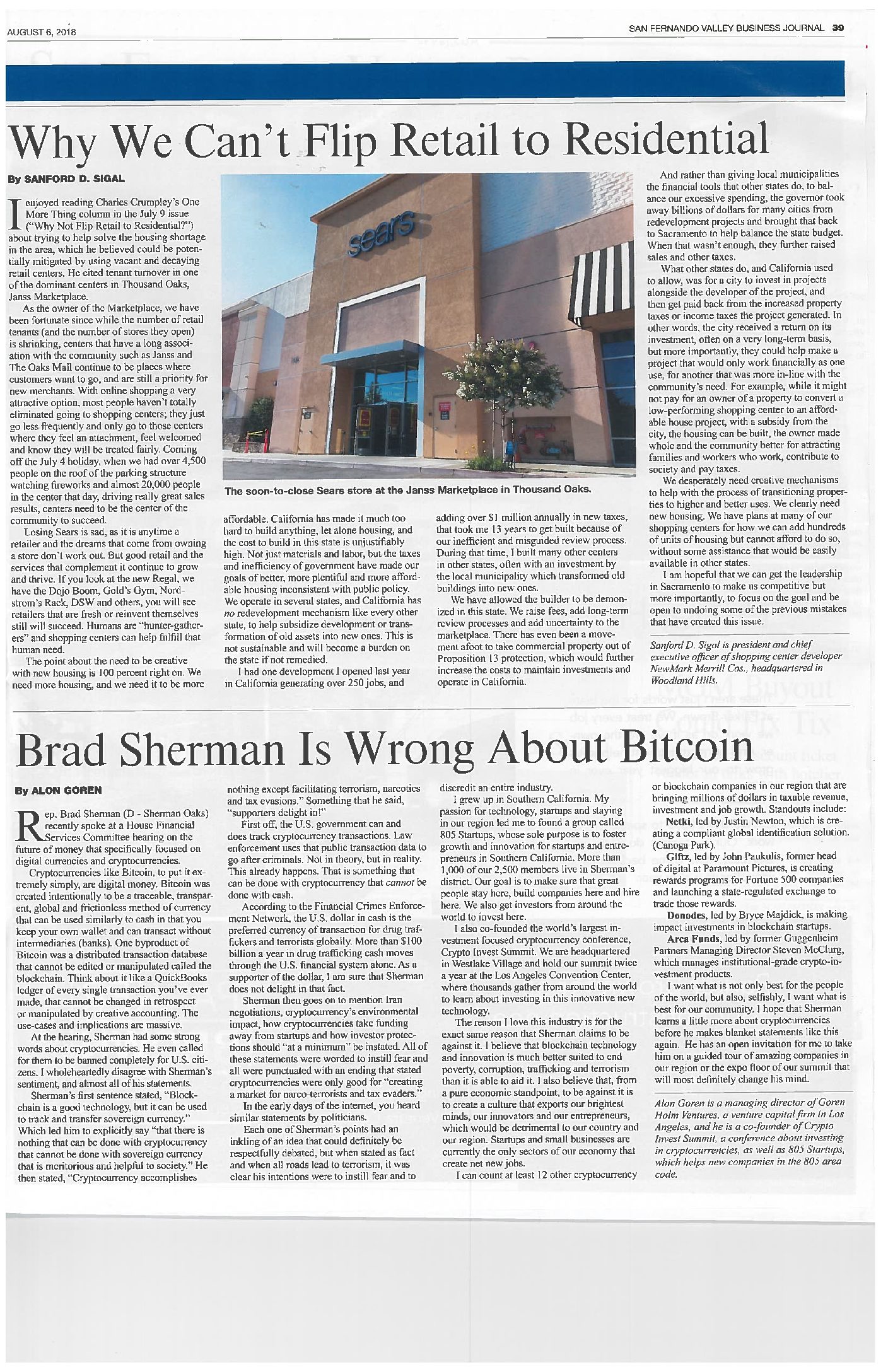
Why We Can’t Flip Retail to Residential
I enjoyed reading Charles Crumpley’s One More Thing column in the July 9 issue (“Why Not Flip Retail to Residential?”) about trying to help solve the housing shortage in the area, which he believed could be potentially mitigated by using vacant and decaying retail centers. He cited tenant turnover in one of the dominant centers in Thousand Oaks, Janss Marketplace.
As the owner of the Marketplace, we have been fortunate since while the number of retail tenants (and the number of stores they open) is shrinking, centers that have a long association with the community such as Janss and The Oaks Mall continue to be places where customers want to go, and are still a priority for new merchants. With online shopping a very attractive option, most people haven’t totally eliminated going to shopping centers; they just go less frequently and only go to those centers where they feel an attachment, feel welcomed and know they will be treated fairly. Coming off the July 4 holiday, when we had over 4,500 people on the roof of the parking structure watching fireworks and almost 20,000 people in the center that day, driving really great sales results, centers need to be the center of the community to succeed.
Losing Sears is sad, as it is anytime a retailer and the dreams that come from owning a store don’t work out. But good retail and the services that complement it continue to grow and thrive. If you look at the new Regal, we have the Dojo Boom, Gold’s Gym, Nordstrom’s Rack, DSW and others, you will see retailers that are fresh or reinvent themselves still will succeed. Humans are “huntergatherers” and shopping centers can help fulfill that human need.
The point about the need to be creative with new housing is 100 percent right on. We need more housing, and we need it to be more affordable. California has made it much too hard to build anything, let alone housing, and the cost to build in this state is unjustifiably high. Not just materials and labor, but the taxes and inefficiency of government have made our goals of better, more plentiful and more affordable housing inconsistent with public policy. We operate in several states, and California has no redevelopment mechanism like every other state, to help subsidize development or transformation of old assets into new ones. This is not sustainable and will become a burden on the state if not remedied.
I had one development I opened last year in California generating over 250 jobs, and adding over $1 million annually in new taxes, that took me 13 years to get built because of our inefficient and misguided review process. During that time, I built many other centers in other states, often with an investment by the local municipality which transformed old buildings into new ones.
We have allowed the builder to be demonized in this state. We raise fees, add long-term review processes and add uncertainty to the marketplace. There has even been a movement afoot to take commercial property out of Proposition 13 protection, which would further increase the costs to maintain investments and operate in California.
And rather than giving local municipalities the financial tools that other states do, to balance our excessive spending, the governor took away billions of dollars for many cities from redevelopment projects and brought that back to Sacramento to help balance the state budget. When that wasn’t enough, they further raised sales and other taxes.
What other states do, and California used to allow, was for a city to invest in projects alongside the developer of the project, and then get paid back from the increased property taxes or income taxes the project generated. In other words, the city received a return on its investment, often on a very long-term basis, but more importantly, they could help make a project that would only work financially as one use, for another that was more in-line with the community’s need. For example, while it might not pay for an owner of a property to convert a low-performing shopping center to an affordable house project, with a subsidy from the city, the housing can be built, the owner made whole and the community better for attracting families and workers who work, contribute to society and pay taxes.
We desperately need creative mechanisms to help with the process of transitioning properties to higher and better uses. We clearly need new housing. We have plans at many of our shopping centers for how we can add hundreds of units of housing but cannot afford to do so, without some assistance that would be easily available in other states.
I am hopeful that we can get the leadership in Sacramento to make us competitive but more importantly, to focus on the goal and be open to undoing some of the previous mistakes that have created this issue.
Sanford D. Sigal is president and chief executive officer of shopping center developer NewMark Merrill Cos., headquartered in Woodland Hi
